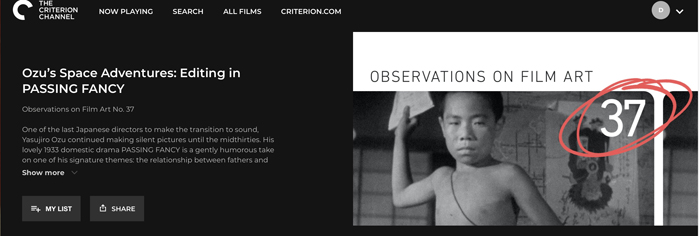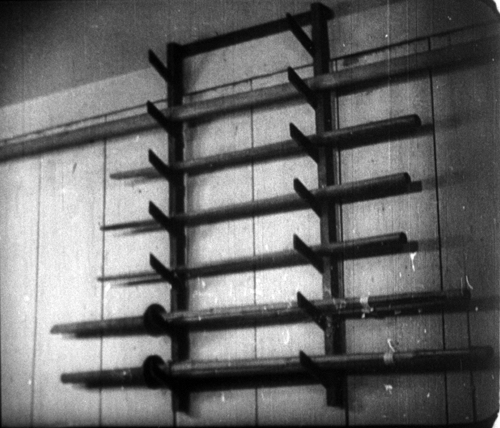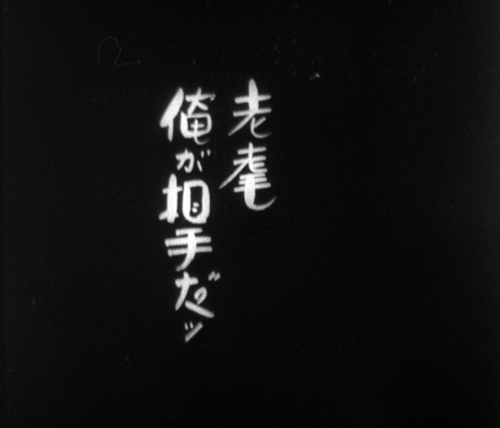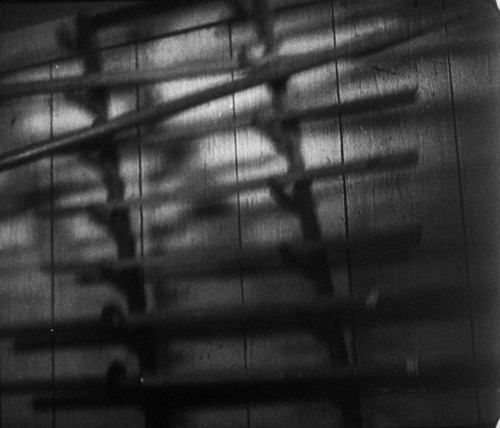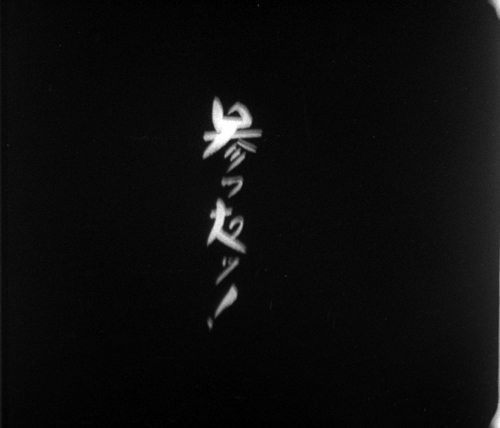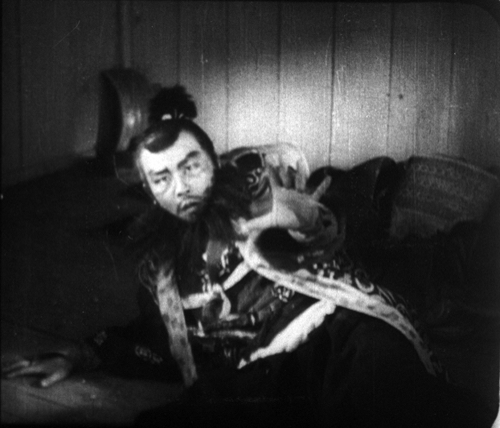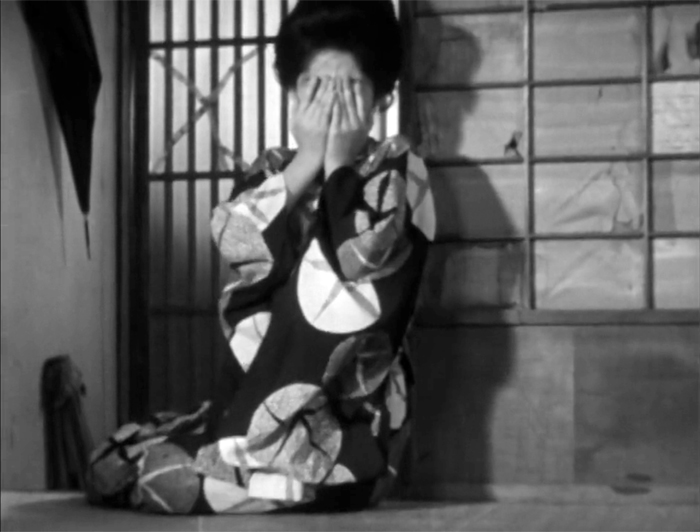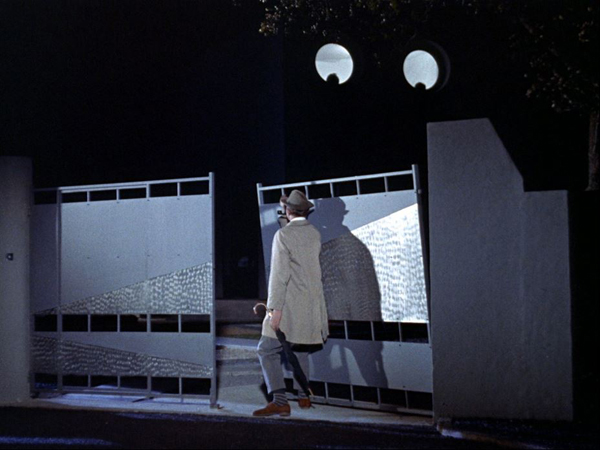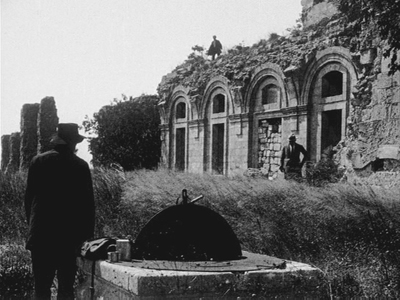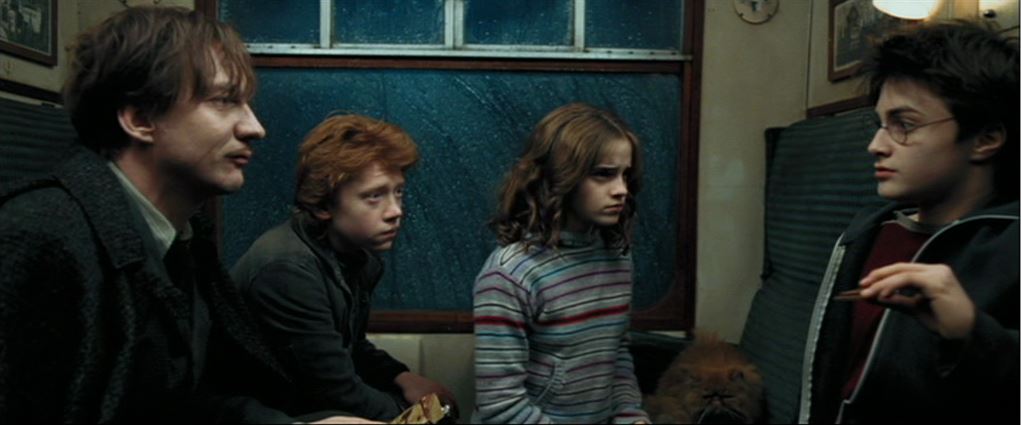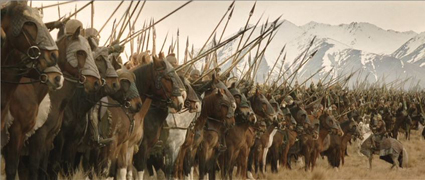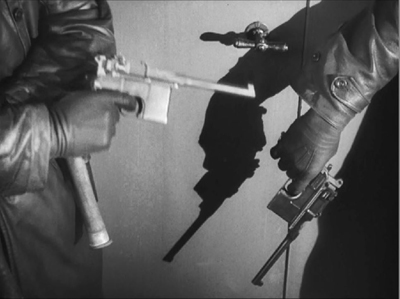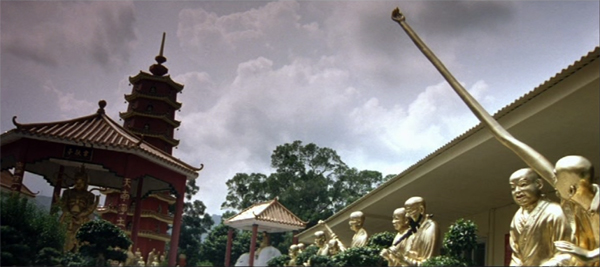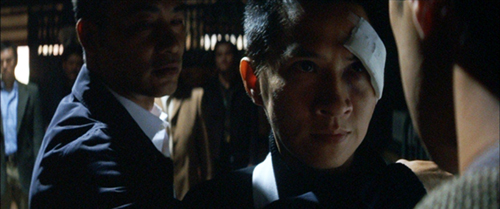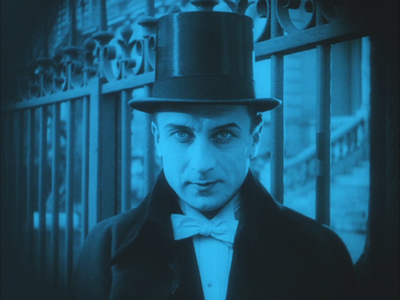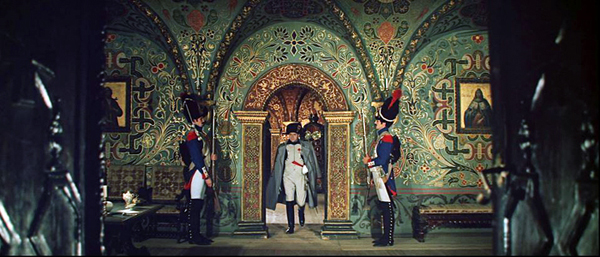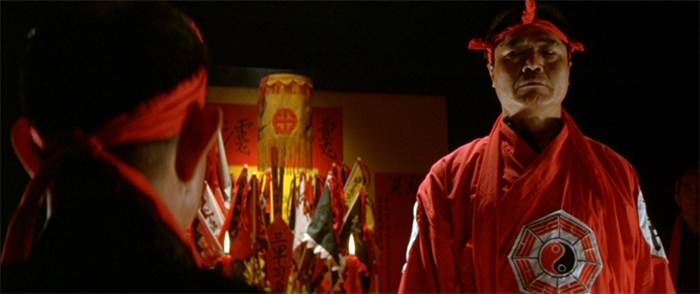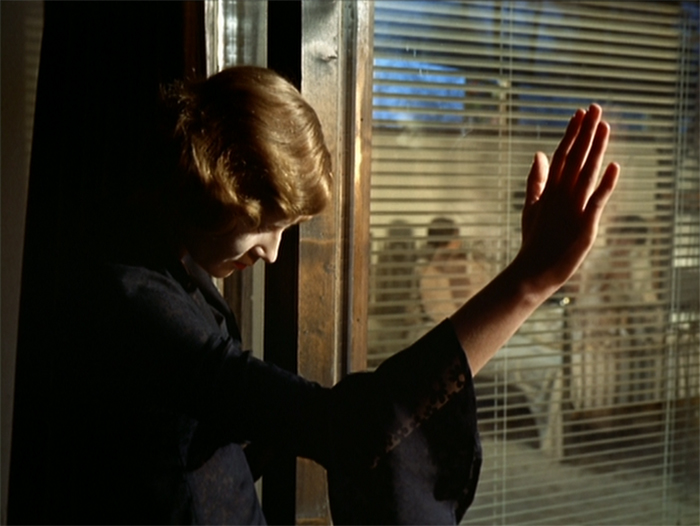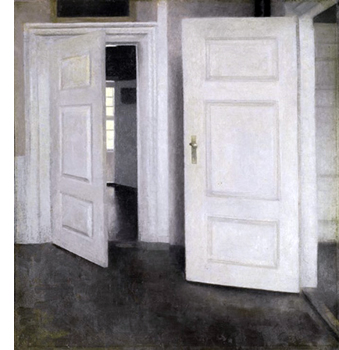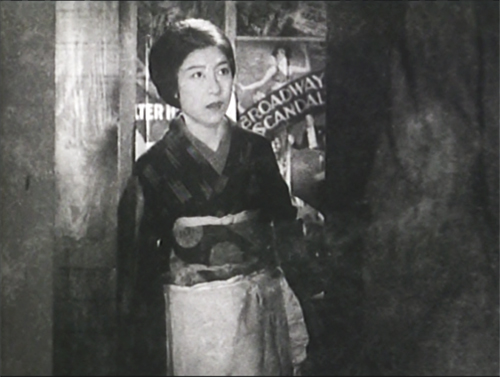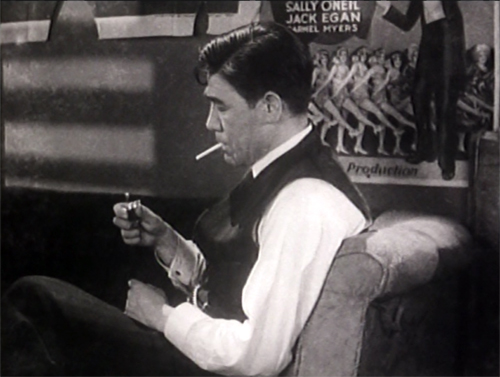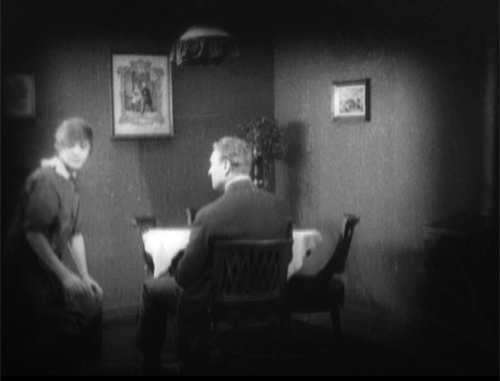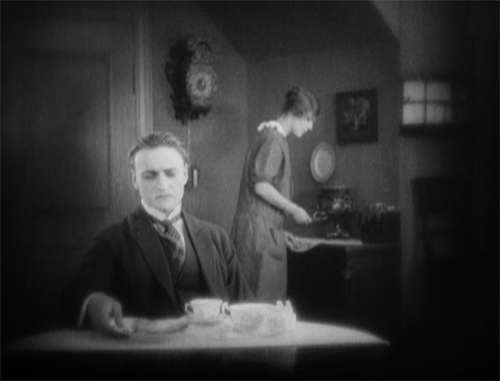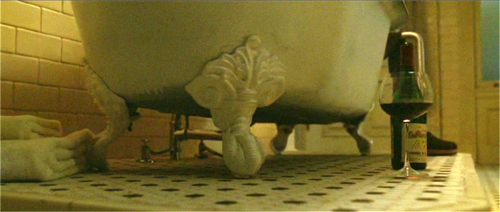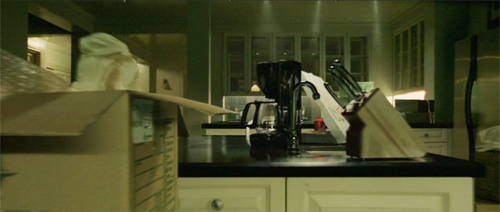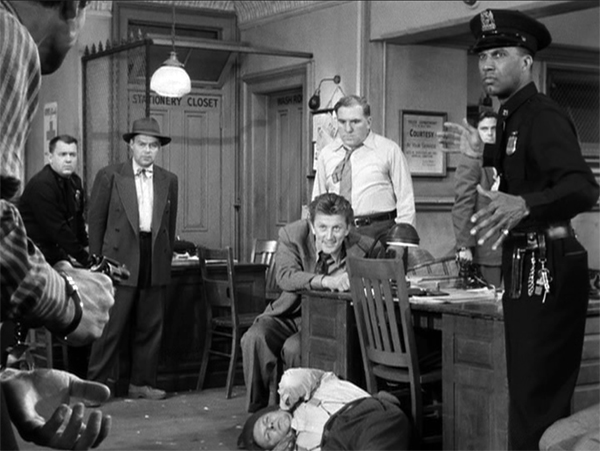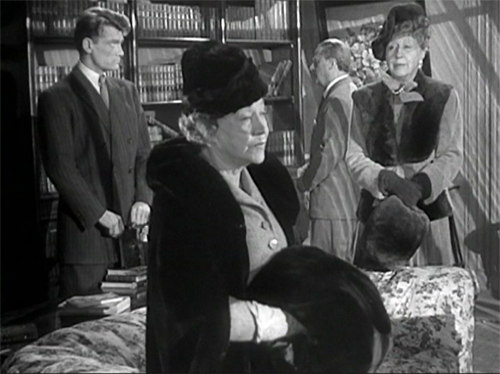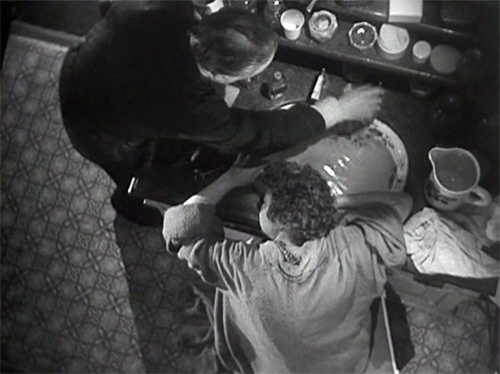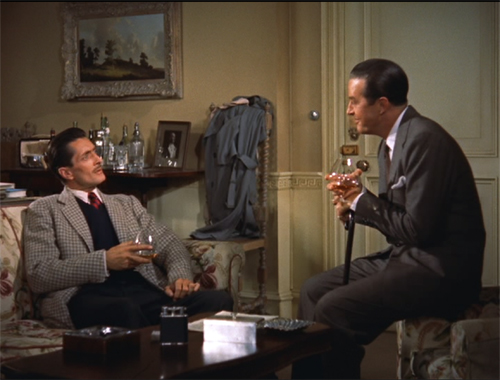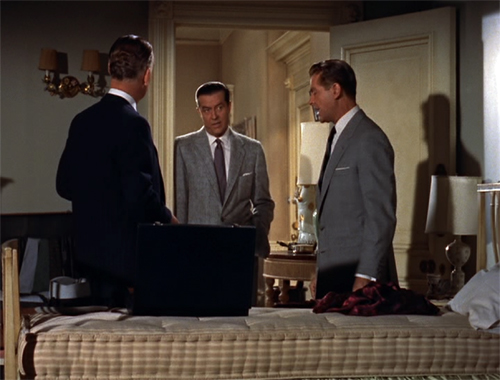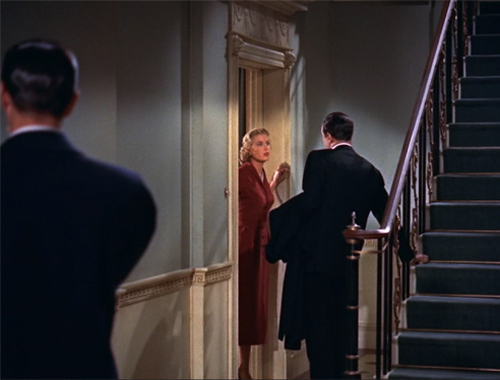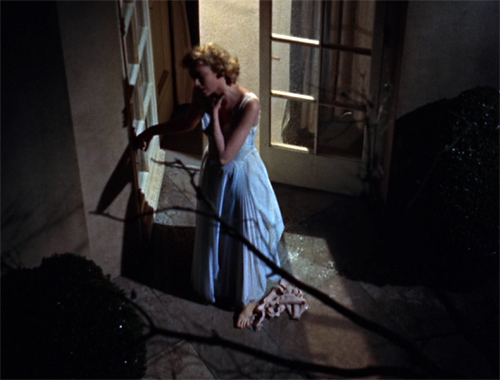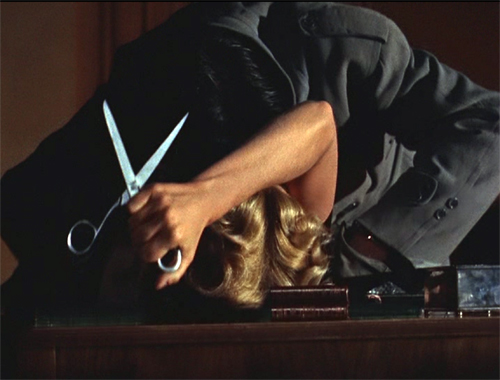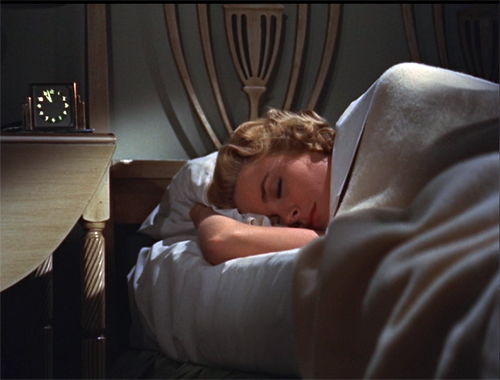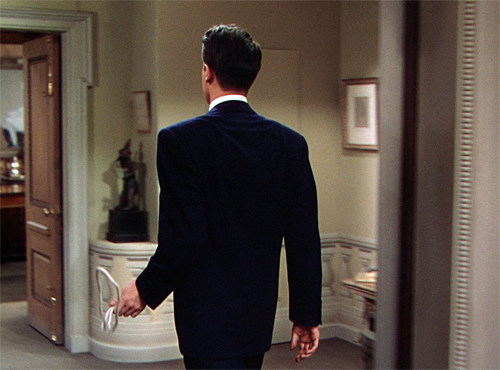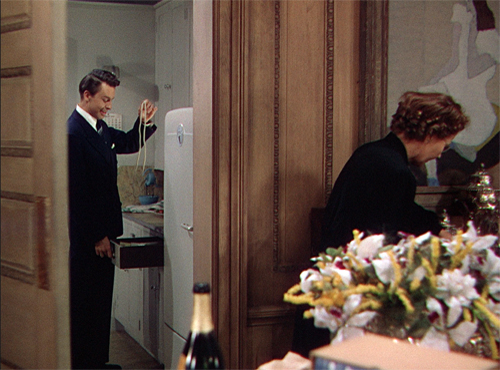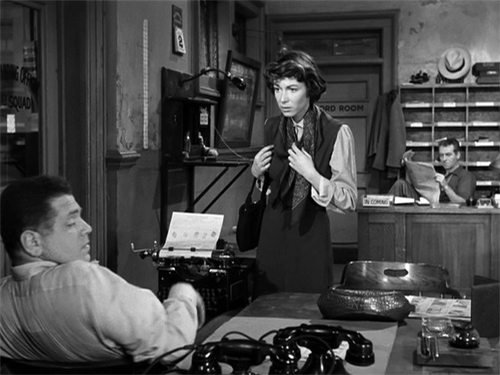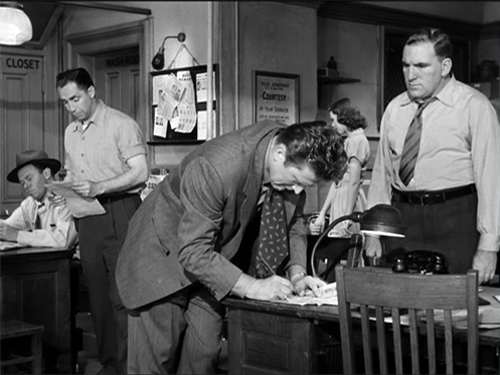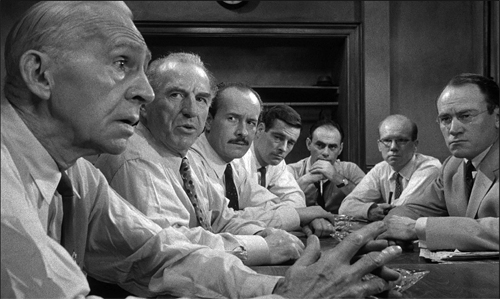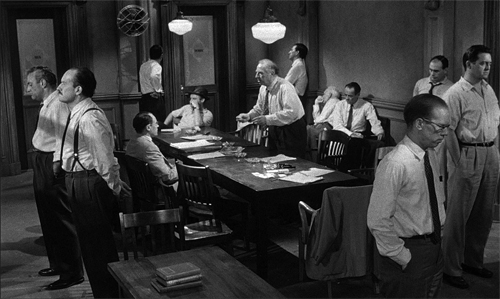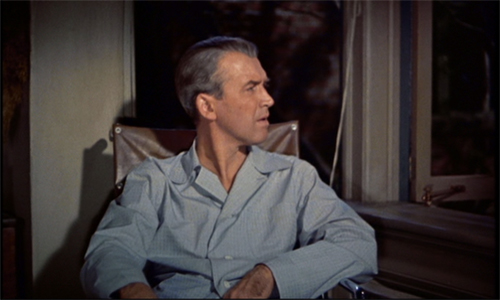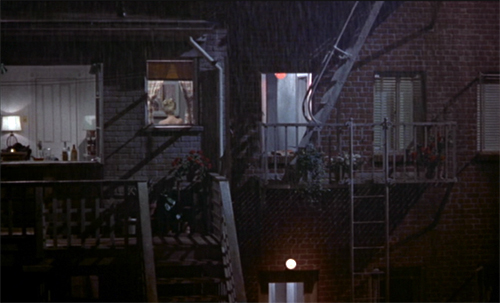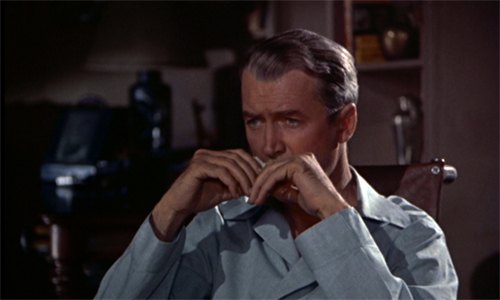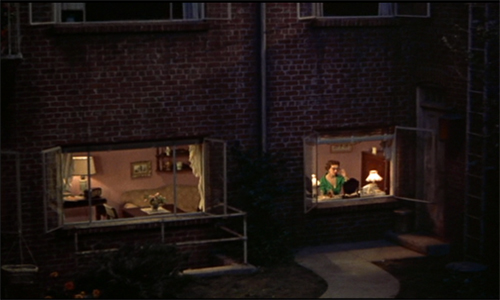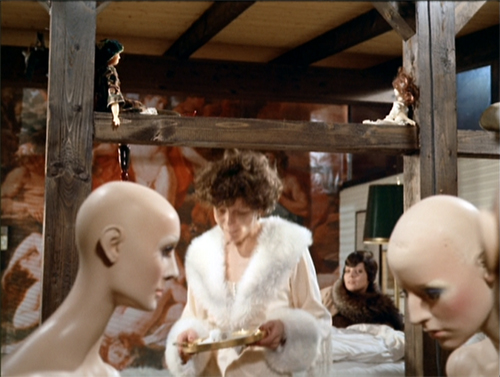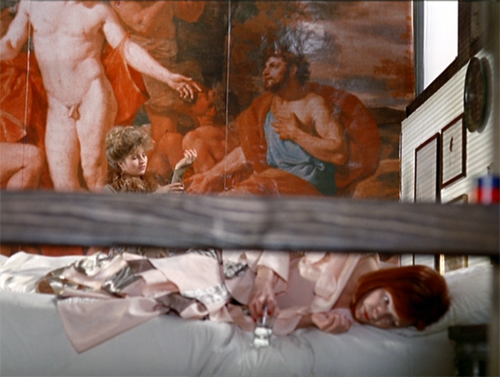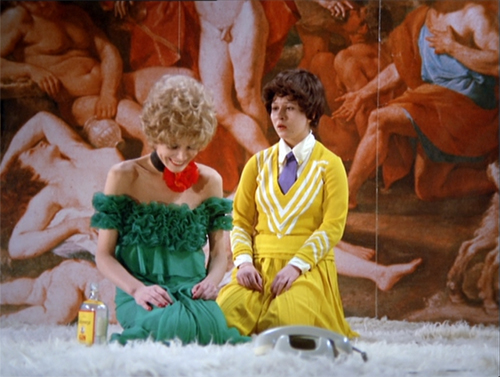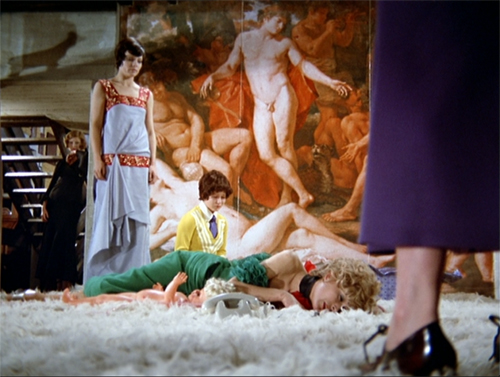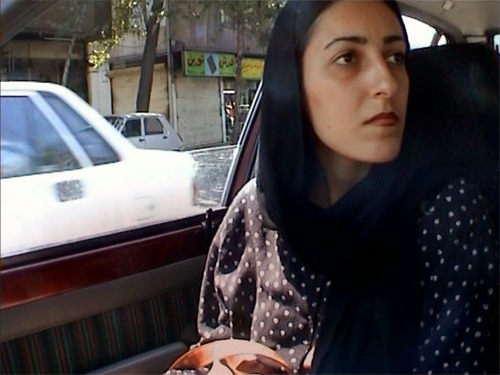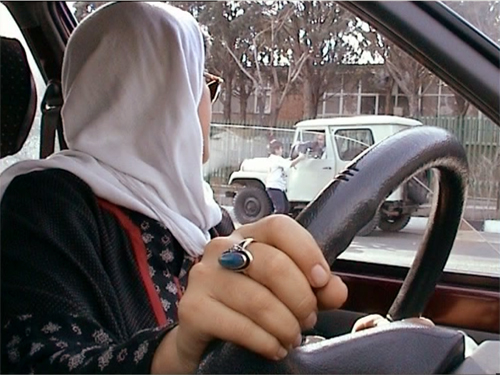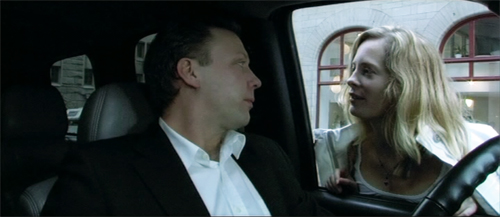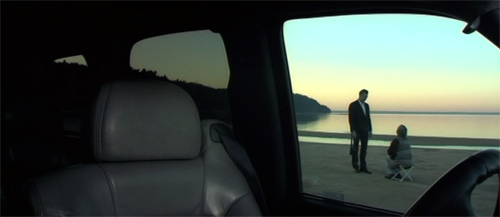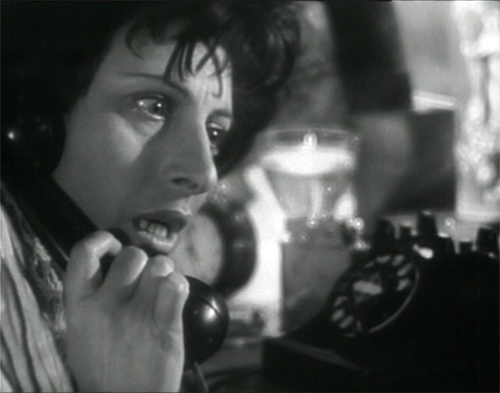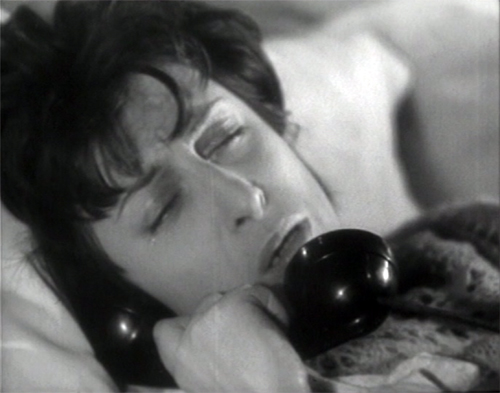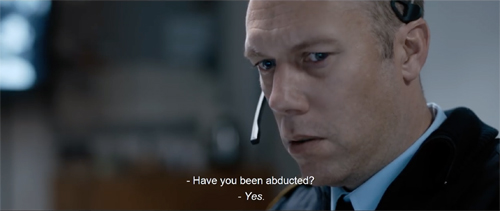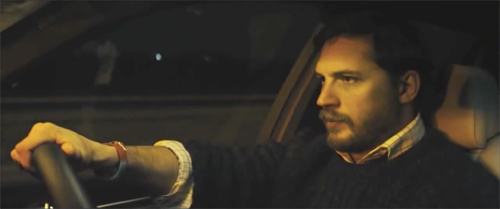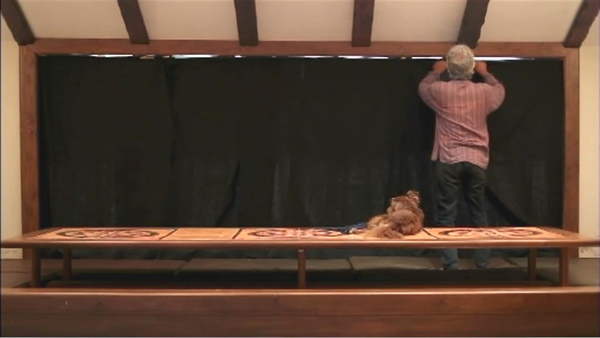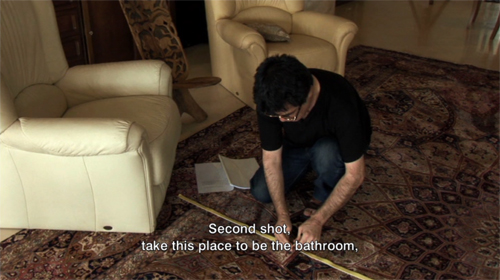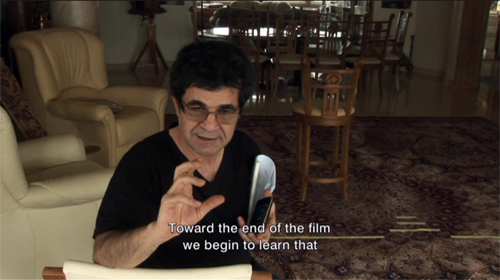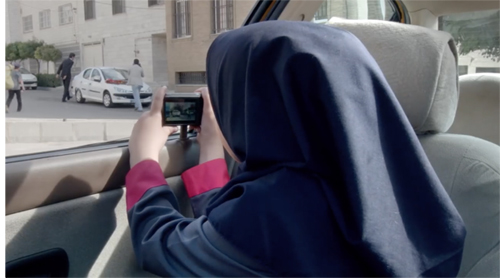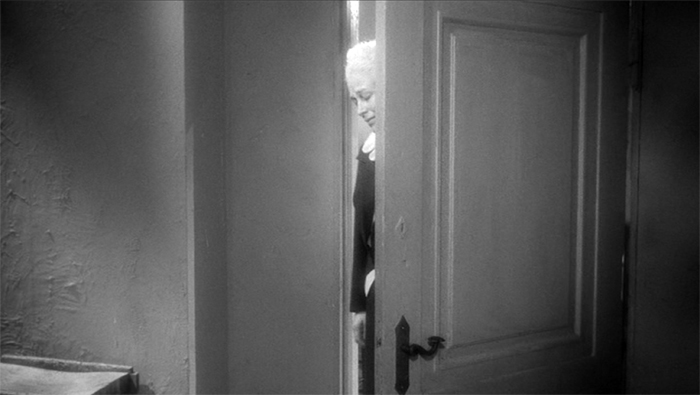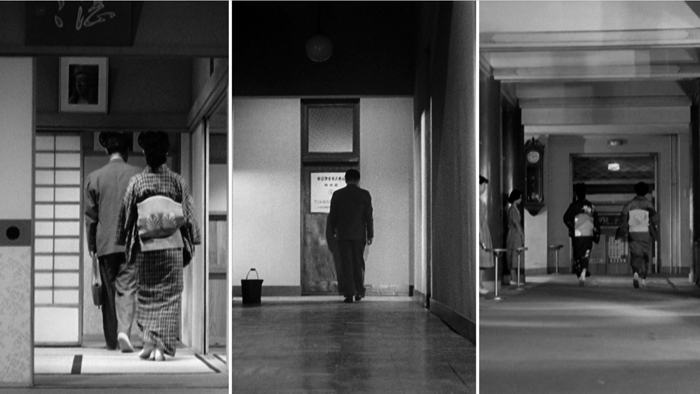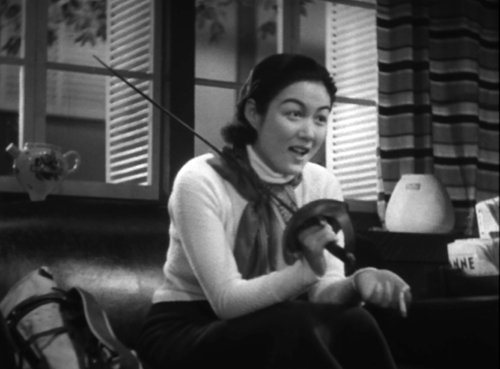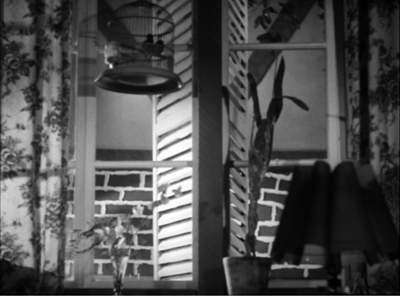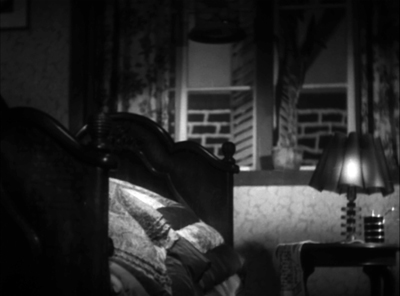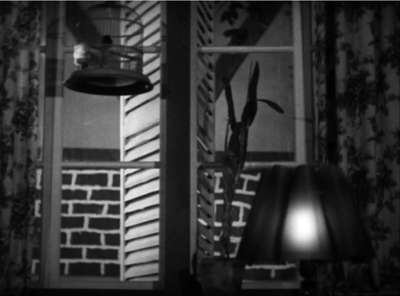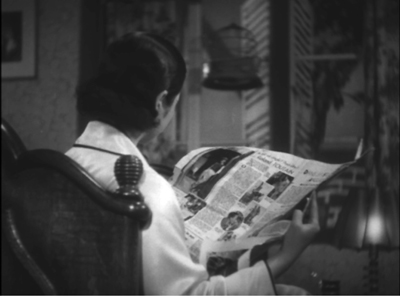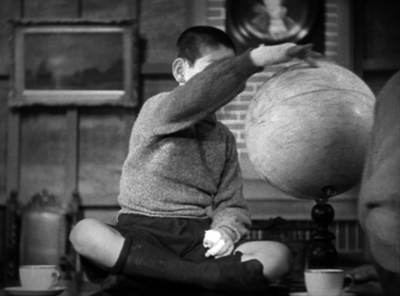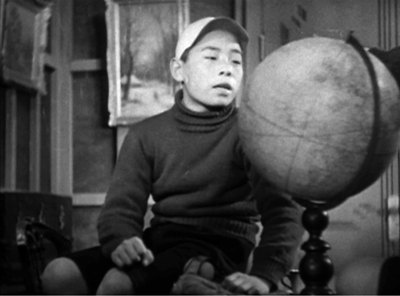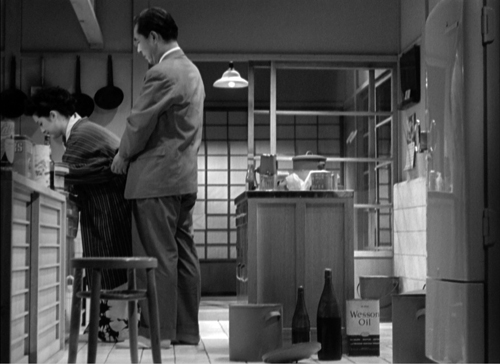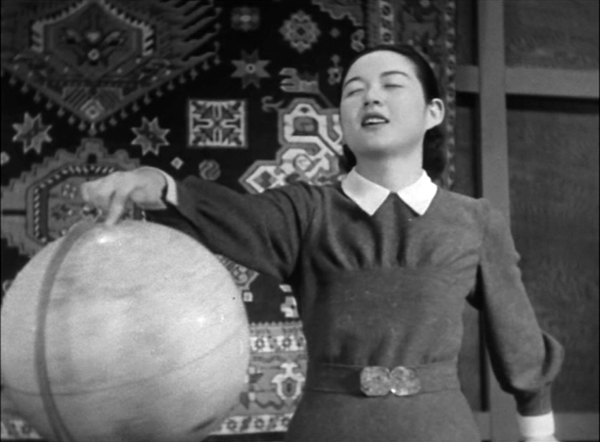Archive for the 'Directors: Ozu Yasujiro' Category
Ozu’s silent talkie: PASSING FANCY on the Criterion Channel
DB here:
Our newest installment of Observations is now up on The Criterion Channel. In it I consider how Ozu’s Passing Fancy (1933) exhibits his distinctive methods for treating a scene’s space. Now, here’s a preview for a little bonus that will show up there next week. It’s a short on how Ozu sometimes relied on sound in a silent film.
You probably know about Japan’s katsuben, or benshi. He or she stood alongside the screen and accompanied the film–explaining the action, commenting on it, and imitating the characters’ voices while reciting the intertitles. The benshi were usually given scripts for the titles’ texts, but they were also expected to expand on them.
Benshi became celebrities, as strong an attraction as the movies, and they wielded power over some production companies. Benshi might reedit films to suit the performance they wanted to give. One reason that talking pictures came only gradually to Japan was the resistance of the benshi associations to being put out of work.
Filmmakers who resented the benshi’s power seemed to have sought to make the films as free-standing as possible. One strategy was to have many intertitles, which served to anchor the meaning of a scene. More positively, in Ozu and the Poetics of Cinema I argue that the presence of a benshi gave filmmakers new storytelling opportunities.
Knowing that the benshi would be speaking the lines in the intertitles, filmmakers could make those titles quite short, creating a swift rhythm. (Contrary to some impressions, Japanese silent movies aren’t slow; even dialogue scenes are likely to be cut fast.) Moreover, the benshi could make conversations more compact than what we find in American films. Instead of a pattern of speaker/title/speaker/listener, your shots could run: speaker/title/listener.
Just as important, filmmakers could count on the benshi to fill in things not shown onscreen. That could allow for some unusual interaction between images and speech.
For example, Iwami Jutaro (1937), a swordplay comedy, treats one scene with “offscreen” sound. A bully is watching a kendo match. Cut to the rack of kendo swords, followed by a cry from one fighter, given in an intertitle: “Fool, you’ll be fighting me!”
Cut back to the rack collapsing, as if shaken by the fight. Another title: “I give up!” is followed by a shot of a fallen fighter, beaten.
The shot of the fallen bully anchors the title, but in the flurry of shots we’re invited to imagine the skirmish. Very likely the benshi was shouting the lines while the accompanying music whipped up a burst of excitement. This elliptical treatment of the match suggests that Kurosawa’s Sugata Sanshiro, made only a few years later, was heir to a tradition of off-center rendering of martial-arts combat.
Ozu recruits the benshi for something more ambitious, as I try to show in this bonus. Regrettably, we couldn’t find usable stills of benshi performances from the period, so the stills illustrate modern revivals. Also, I still haven’t seen Suo Masyuki‘s recent Talking the Pictures (Katusben!, 2019), a comedy about benshi culture.
Anyhow, a little analysis of what we have enables us to appreciate how Ozu uses the benshi to emphasize character reactions. The highlight comes in an emotional climax, when the benshi’s sobs would have filled in offscreen action.
Ozu, a fan of Western cinema, would have seen talkies and realized the power of offscreen sound. But I suspect he didn’t need external influences to understand that the benshi’s patter gave directors great freedom in visual narration.
Passing Fancy is one of three masterpieces Ozu released in 1933. (The other two, Dragnet Girl and Woman of Tokyo, are also on the Channel.) The Japanese cinema of this period was one of the glories of world filmmaking, with talent at all levels. Still, very few directors anywhere matched Ozu’s quietly outrageous innovations in form and style, his urge to show us cinema, and so the world, in a poignant, exhilarating way.
Thanks to Kim Hendricksen, Peter Becker, Grant Delin, Erik Gunneson, and the team at Criterion for enabling me to include this clip on our site. Thanks also to Komatsu Hiroshi for information on Iwami Jutaro and Steve Ridgely for correction of one of the intertitles.
For more on the benshi, see the comprehensive study Benshi, Japanese Silent Film Narration, and the Forgotten Narrative Art of Setsumei: A History of Japanese Silent Film Narration, by Jeffrey A. Dym (Edwin Mellon Press, 2003). Fascinating background on the struggles between the benshi and other sectors of Japanese film culture can be found in Joanne Bernardi, Writing in Light: The Silent Scenario and the Japanese Pure Film Movement (Wayne State University Press, 2001) and Aaron Gerow, Visions of Japanese Modernity: Articulations of Cinema, Nation, and Spectatorship, 1895-1925 (University of California Press, 2010).
Another intriguing review of Talking the Pictures is Jessica Klang’s in Variety.
Ozu and the Poetics of Cinema is available for free download here. (Be patient; the file is big.) An earlier Observations segment considered Kurosawa’s cutting of martial-arts action, and a blog entry developed that a bit more.
Another way to make a silent talkie is discussed in this entry on The Donovan Affair.
Passing Fancy (1933).
Quality bingeing
Mon Oncle (1958)
Kristin here:
Or binging, if you prefer. Either is an acceptable spelling.
Streaming entertainment is one of the things that are saving our sanity as we sit in our homes. With the theaters closed and new movies either delayed or sent straight to streaming, movie critics, other journalists, and movie buffs are now making best-films-to-stream-during-the-pandemic lists a new and common genre across the internet.
Maybe you’ve been streaming a lot of TV series, even ones you’ve already seen, and are feeling a bit guilty about that. Maybe you’re longing for something more worthwhile to watch but wishing that that something would take up more time than your average feature film.
For those people, I offer a list of films to binge. These are either long in themselves or are split up into many parts that can be binged just like TV series. Others are stand-alones but can be grouped in meaningful ways.
My experience is that online disc orders are taking longer than usual. With Amazon prioritizing health and work-at-home supplies, Blu-rays are taking around two weeks rather than two days. (David and I, of course, count Blu-rays and streaming as part of our work-at-home requirements.) While you’re waiting, I’ll bet many of you have some of these discs on your shelves already and have always meant to make time for them. That time, lots of it, has arrived.
Serials
Many fine serials were made in the silent era, but Louis Feuillade remains the director that most of us think of first in relation to this format. His three great serials of the 1910s (not including, alas, the fine Tih Minh [1918]) are available on home video.
Fantômas (1912). 5 episodes, 337 minutes. Fantômas is available in Blu-ray and DVD from Kino Lorber. David wrote a viewer’s guide to it here.
Les Vampires (1915). 10 episodes, 417 minutes. Les Vampires is available on Blu-ray and DVD from Kino Lorber. As far as I can tell, it is streaming only on Kanopy (apart from unwatchable public domain pre-restoration prints).
Judex (1917). 12 episodes, 315 minutes. Judex is ordinarily available from Flicker Alley, though it is currently listed as out of stock. Amazon has 5 left. For maximum bingeing opportunities, watch all three serials in a row and then stretch them out with Georges Franju’s charming remake, Judex (1963) for an extra 98 minutes (it’s $2.99 to stream it on Amazon Prime).
Miss Mend (Boris Barnet, 1926). Three episodes, 235 minutes. The only American-style serial from the Soviet Union that I know of, or at least the only one easily available. I wrote about it briefly when it first came out from Flicker Alley. You can still get it from Flicker Alley or Amazon. We wrote briefly about it here.
Le Maison de mystère (Alexandre Volkoff, 1923). 10 episodes, 383 minutes. I’ve already written in some detail about this long-lost serial. It’s probably not as good as Feuillade’s best, but it’s good fun and beautifully photographed (see top of section) and acted–and long enough to require a meal break. Fans of the great Ivan Mosjoukine (as he spelled his name after emigrating from Russia to France) will especially want to see this one. Available from Flicker Alley
Berlin Alexanderplatz (Rainer Werner Fassbender, 1980) 13 episodes and an epilogue. 15 hours, 31 minutes. Back when it first came out, this was treated more as a film than a TV series. It showed in 16mm at arthouses and archives. David and I drove to Chicago to see the whole thing in batches over a single weekend at The Film Center (now the Gene Siskel Film Center). It’s available on either DVD or Blu-ray as a Criterion Collection set (#411 for you Criterion number-lovers). It’s also streaming on the Channel. Both have a batch of supplements, even the 1931 German film of the novel, so you can stretch the experience out even longer.
Silent serials may work for some families, if the kids have been introduced to silents already through the more obvious route of films with Buster Keaton, Charlie Chaplin, and the other great comics of the era. If not, families can fill their time with more recent films in episodes with continuing stories.
The serial format has had a comeback in recent decades, partly due to the influence of the first Star Wars trilogy and partly to the need for ever expanding amounts of moving-image content in the era of home-video, cable, and internet services. For those who want to binge Star Wars, you don’t need my guidance. Anyway, I gave up after the first of the recent series, the one where Adam Driver took over as the villain. (Not that I have anything against Adam Driver. It was the film.) Even daily life in a pandemic is too short for more.
The Harry Potter series. (2001-2011) Eight episodes, 990 minutes, or 16.5 hours. This series is not high art, but it’s pretty good, highly entertaining (to some, at least), and even has one episode, number three, directed by Alfonso Cuarón, HP and the Prisoner of Askaban (above). The others are HP and the Sorcerer’s Stone (or Philosopher’s Stone in the UK and elsewhere; Chris Columbus), HP and the Chamber of Secrets (Chris Columbus), HP and the Goblet of Fire (Mike Newell), HP and the Order of the Phoenix, HP and the Half-Blood Prince, HP and the Deathly Hallows: Part I, and HP and the Deathly Hallows: Part II (the last four, David Yates). These films are, of course, available in multiple versions, on disc and streaming. As far as I can tell, none of the complete boxed sets have the two last parts in 3D; those have to be purchased separately. Having seen the last film in a theater in 3D, I can say that it doesn’t seem to be one of those films that is much improved if one sees it that way (unlike Mad Max: Fury Road, in the section below).
The Hobbit and The Lord of the Rings extended editions: An Unexpected Journey (2012), The Desolation of Smaug (2013), The Battle of the Five Armies (2014), The Fellowship of the Ring (2001), The Two Towers (2002), and The Return of the King (2003, above). 6 episodes, 1218 minutes, or 20 hours, 18 min. Yes, for sheer length this serial tops them all. Plus there are lots of supplements. Each part of the Hobbit films has one commentary track and a bunch of making-ofs, adding up to 40 hours, 5 1/2 minutes. This pales, however, in comparison with the LOTR extended editions, which have four commentary tracks, totaling 45 hours, 44 minutes. The making-ofs are hard to get exact figures for, but I estimate about 22 hours for all three films. That’s about 68 hours of audio and visual supplements.
To top that off, the Blu-ray set contains the three feature-length documentaries by Costa Botes: The Fellowship of the Rings: Behind the Scenes, The Two Towers: Behind the Scenes, and The Return of the King: Behind the Scenes, all adding another 5 hours, 2 1/2 minutes. (Botes’s films were also included in a “Limited Edition” reissue of the theatrical versions of the LOTR films in 2006.) In toto, if one watches every single item and listens to all the commentaries, one could escape 133 hours and 10 minutes of isolation boredom–and possibly go mad in the process. But treating the bingeing as an eight-hour-a-day job, it would come to 16 1/2 days.
All this does not include the supplements accompanying the theatrical-version discs. These are charming but more oriented toward introducing complete neophytes to the universe of Middle-earth than toward giving filmmaking information.
Series
Series, as opposed to serials, usually involve continuing characters but self-contained stories. Most of the series below could be watched out of order without suffering much. It would help to watch Mad Max first, since it’s an origin story. The Apu Trilogy should be watched in order because it’s about the central character’s stages of life. Each of the M. Hulot films bears the traces of the contemporary culture in which it is set, but one can understand each fine out of order. I saw Traffic first, in first run, and then saw the others.
Mad Max (1979), Mad Max 2, aka The Road Warrior (1981), Mad Max Beyond Thunderdome (1985), and Mad Max: Fury Road (2015) add up to 411 minutes, or 6 hours and 51 minutes. You know them, you love them–but have you ever watched them straight through? We’ve written about Fury Road (here and here). That’s a film where the 3D really does play an active role.
Jacques Tati’s Monsieur Hulot films: Mr. Hulot’s Holiday (1953), Mon Oncle (1958, see top), Play Time (1967), and Traffic (1971). They add up to 7 hours and 4 minutes. Or add his non-Hulot films, Jour de fête (1949) and Parade (1974) for just under an additional 3 hours of hilarity. You can buy all of Tati’s films at The Criterion Collection or stream them at The Criterion Channel. Throw in my “Observations on Film Art” segment on Parade for an extra 12 minutes. And check out Malcolm Turvey’s new book, Play Time: Jacques Tati and Comedic Modernism, soon to be discussed in a portmanteau books blog here.
Dr. Mabuse films plus Spione: Dr. Mabuse, der Spieler (1922), Spione (1928, frame above), The Testament of Dr. Mabuse (1933) and The Thousand Eyes of Dr. Mabuse (1960), adding up to 610 minutes, or 6 hours and 10 minutes. Few if any directors have extended a series over such a stretch of time, and the Mabuse films are quite different from each other (including having different actors play the master criminal). I throw Spione into the mix because the premise and tone are so similar to the first Mabuse film. Haghi is basically Mabuse as a master spy instead of a gambler and general creator of chaos; given that he’s played by Rudolf Klein-Rogge, who was the first Mabuse, the comparison is almost inevitable. One can almost imagine Haghi as just another of Mabuse’s disguises and it fits right into the series. I’ve linked the streaming sources to the titles above.
Kino Lorber has the restored version of Der Spieler on DVD and Blu-ray, Eureka has the restored version of Spione on DVD and Blu-ray (note: Region 2 coding) The Criterion Collection offers a DVD of Testament, and Sinister Cinema has a DVD of The 1,000 Eyes. (For those who want to dig deeper, there a Blu-ray set of all of Lang’s silents, from Kino Classics and based on the F. W. Murnau Stiftung restorations. That totals 1894 minutes, or about 31 and a half hours. I don’t know if that counts the supplements, but there are lots of them.)
Apu Trilogy: Pather Panchali (“Song of the Little Road,” but nobody calls it that, 1955), Aparajito (1956), and The World of Apu (1959). 341 minutes. Satyajit Ray’s trilogy may seem like a serial, in that it follows the life of the main character, Apu. Yet Ray had not planned a sequel until Pather Panchali achieved international success, and the films have big time gaps in between, with no dangling causes. These are three of the most beautiful, touching films ever made, and the stunning restoration from a damaged negative and other materials is little short of a miracle. If you have never seen these or saw them before the restoration, do yourself a favor and binge them. Have some tissues handy, and I don’t mean for stifling coughs and sneezes. Available on disc from The Criterion Collection and streaming on The Criterion Collection here, here, and here.
Now I briefly cede the keyboard to David for his recommendations of Hong Kong series.
Triads vs. cops, Triads vs. Triads
Infernal Affairs (2003).
There are many delightful Hong Kong series. I enjoy the silly Aces Go Places franchise (1982-1989) and the pulse-pounding Once Upon a Time in China saga (1991-1997). Alas, almost none of these installments entries are represented on streaming. I could find only the weakest OUATIC title, Once Upon a Time in China and America (1997) on Amazon Prime, Vudu, and iTunes.
If you want to go for samples, there are two diversions from the ever-lively Fong Sai-yuk series. The Legend (US title of the first entry, a bit pricy from Prime). The more reasonably priced Legend II, the US version of the second entry, has a fantastically funny martial-arts climax featuring Josephine Siao Fong-fong as Jet Li’s mom. This is available from several streamers. Older kids won’t find either one too rough, I think.
There are two outstanding series more suitable for adult bingeing. Infernal Affairs (2003-2004) was made famous by Scorsese’s remake The Departed (2006), but the original is better, and the follow-ups are loopier. The first entry offers solid, suspenseful plotting and meticulous performances by top HK stars Tony Leung Chui-wai and Andy Lau Tak-wah, supported by a rogues’ gallery of unforgettable character actors. Parts two and three spin off variations on the first one, tracing out before-and-after incidents and throwing in some quite strange narrative contortions. The whole thing provides an engrossing five and a half hours of entertainment. Available from several services.
In my book Planet Hong Kong I analyze the trilogy as an example of how directors Andrew Lau and Alan Mak Siu-fai created a more subdued thriller than is usual in their tradition. Bonus material: In the spirit of providing free stuff during the crisis, here in downloadable pdf form is my little chapter on the trilogy: Infernal Affairs interlude.
Also subdued, even subtle, is Johnnie To Kei-fung’s Election (2005) and Election 2 (aka Triad Election, 2006). These films dared to show secret gang rituals that other filmmakers shied away from. The first part plays out ruthless competition among rival Triad leaders, including strikingly unusual methods of punishing one’s adversary. The second entry, even more audacious, suggests that Hong Kong Triad power is intimately tied up with mainland Chinese gangs, backed up by political authority.
Johnnie To’s pictorialism, so feverish in The Longest Nite (1998), A Hero Never Dies (1998), The Mission (1999), and other films, gets a nice workout here as well. Infernal Affairs is agreeably moody, but the Election films are black, black noir.
The pair add up to three hours and a quarter. The first film is apparently available only on disc but the second is streaming from several sources.
Of course, to get into the real Hong Kong at-home experience, some viewers will find all these films easily and cost-free on the Darknet.
Thematic combos
Flicker Alley’s Albatros films. 5 films, 664 minutes, or 11 hours and 4 minutes. I wrote about the DVD set, “French Masterworks: Russian Émigrés in Paris 1923-1929” when it first came out. It’s still available here. The Albatros company made some of the key films of the 1920s, most of which are still too little known, including Ivan Mosjoukine’s Le brasier ardent (1923, above). If this is still a gap in your viewing of French films, here’s a chance to fill it.
Yasujiro Ozu: The Criterion Collection has released a helpful thematic grouping of some of Ozu’s early films. One is “The Silent Ozu: Three Family Comedies” (DVD and streaming), including I Was Born, but …, Tokyo Chorus, and Passing Fancy, adding up to 281 minutes. The British Film Institute has gone further along the same lines, releasing “The Gangster Films,” also three silents: Walk Cheerfully (1930), That Night’s Wife (1930), and the wonderful Dragnet Girl (1933); they add up to 259 minutes. The BFI has also put out “The Student Films,” (listed as out of stock at the moment) yet more silents: Ozu’s earliest complete surviving film, Days of Youth (1929), I Flunked, But … (1930), The Lady and the Beard (1931) , and Where Now Are the Dreams of Youth? (1932), adding up to 251 minutes.
David has recorded an entry on Ozu’s Passing Fancy for our sister series, “Observations on Film Art,” on the Criterion Channel; it should go online there sometime this year.
Or watch all the “season” films in a row: Late Spring (1949), Early Summer (1951), Early Spring ((1956), Equinox Flower (1958), Late Autumn (1960), End of Summer (1961), and An Autumn Afternoon (1962), for a grand total of 840, or 14 hours. Including An Autumn Afternoon is cheating a bit, since the original title means “The Taste of Mackerel.” Still, it’s so much like the earlier films in equating a season with a stage of life that the English title seems perfect. The early films equate the seasons with the young people, about to marry or recently married, while in the later films, and especially the last three, the seasons refer to the older generation, lending an elegiac tone to the end of Ozu’s career. David has done commentary for the DVD of An Autumn Afternoon.
All of these (except for Days of Youth) and many other Ozu films can be streamed on The Criterion Channel, which also has a bunch of supplements on this master director.
Or just watch The Criterion Channel’s Kurosawa films in chronological order, or Bresson’s or Godard’s or Bergman’s or …
Or watch all of Hideo Miyazaki’s films in chronological order, with or without the company of kids.
Just really long films
War and Peace (Sergei Bondarchuk, 1965-1967, above) 4 parts: 7 hours, 3 minutes, 44 seconds. I suppose this is technically a serial, since the parts were released over three years. Still, the idea presumably was that it ultimately should be seen as one film, and the running time would permit it being seen in one day fairly easily. I have not seen this restored version, only the considerably cut-down American release back when it first came out. I remember it as being quite conventional, but on a huge scale in terms of design, cinematography, and crowds of extras. Seeing it in its original version would no doubt be impressive (see above). Available on disc at The Criterion Collection and streaming on The Criterion Channel. The supplements total 175 minutes and four seconds, pushing the total up to nearly 10 hours.
Satan’s Tango (Béla Tarr, 1994) 450 minutes, or 7 hours 30 minutes. Film at Lincoln Center has just made Tarr’s epic available for streaming; you can rent it for 72 hours and support a fine institution. As to owning it, the DVDs seem to be out of print. There is, however, a Blu-ray coming from Curzon Artificial Eye on April 27 in the UK. Pre-order it here. Obviously many of us will still be stuck inside by the time it arrives. Or if you have it on the shelf and never quite got around to watching it, here’s your chance. Derek Elley’s Variety review sums up its pleasures. Our local Cinematheque has shown it twice, once in 35mm and more recently on DCP (see here, with the news buried at the bottom of the story). David reported on that first showing, and later he wrote a general entry about Tarr’s work on the occasion of having met the man himself.
Shoah (Claude Lanzmann, 1985) 550 minutes, or 9 hours and 10 minutes. The Holocaust examined through modern interviews with a broad range of people involved. Available in a restored version on disc from The Criterion Collection. It does not seem to be available currently for streaming.
Unclassifiable
Then there’s Dau (2020-), a biopic of a Soviet scientist that is perhaps the most ambitious filmmaking venture ever.
Shot on 35mm over three years in a real working town with 400 characters played by actors who remained in character and costume round the clock the whole time. Few have seen these, though two showed at the Berlin festival this year. We haven’t seen them but plan to give it a go, since they have just shown up online. Here’s a helpful summary of the project. At the Dau Cinema website, you can stream the first two films for $3 each: Dau. Natasha (2:17:53) and Dau. Degeneration, (6:09:06) adding up to 8 hours and 27 minutes. Twelve more films are announced for future release, with no timings given. Clearly not suitable for family viewing.
I have not attempted to add up all these timings, but if you can track most of them down, they might get you through much of the isolation period. Stay safe!
Election (2005).
Stuck inside these four walls: Chamber cinema for a plague year
The Bitter Tears of Petra von Kant (1972).
Privacy is the seat of Contemplation, though sometimes made the recluse of Tentation… Be you in your Chambers or priuate Closets; be you retired from the eyes of men; thinke how the eyes of God are on you. Doe not say, the walls encompasse mee, darknesse o’re-shadowes mee, the Curtaine of night secures me… doe nothing priuately, which you would not doe publickly. There is no retire from the eyes of God.
Richard Brathwaite, The English Gentlewoman (1631)
DB here:
We’re in the midst of a wondrous national experiment: What will Americans do without sports? Movies come to fill the void, and websites teem with recommendations for lockdown viewing. Among them are movies about pandemics, about personal relationships, and of course about all those vistas, urban or rural, that we can no longer visit in person. (“Craving Wide Open Spaces? Watch a Western.”)
Cinema loves to span spaces. Filmmakers have long celebrated the medium’s power to take us anywhere. So it’s natural, in a time of enforced hermitage, for people to long for Westerns, sword and sandal epics, and other genres that evoke grandeur.
But we’re now forced to pay more attention to more scaled-down surroundings. We’re scrutinizing our rooms and corridors and closets. We’re scrubbing the surfaces we bustle past every day. This new alertness to our immediate surroundings may sensitize us to a kind of cinema turned resolutely inward.
Long ago, when I was writing a book on Carl Dreyer, I was struck by a cross-media tradition that explored what you could express through purified interiors. I called it “chamber art.” In Western painting you can trace it back to Dutch genre works (supremely, Vermeer). It persisted through centuries, notably in Dreyer’s countryman Vilhelm Hammershøi (below).
Plays were often set in single rooms, of course, but the confinement was made especially salient by Strindberg, who even designed an intimate auditorium. For cinema, the major development was the Kammerspielfilm, as exemplified in Hintertreppe (1921), Scherben (1921), Sylvester (1924), and other silent German classics. Kristin and I talk about this trend here and here.
In the book I argued that Dreyer developed a “chamber cinema,” in piecemeal form, in his first features before eventually committing to it in Mikael (1924) and The Master of the House (1925). Two People (1945) is the purest case in the Dreyer oeuvre: A couple faces a crisis in their marriage over the course of a few hours in their apartment. (Unfortunately, it doesn’t seem available with English subtitles.) But you can see, thanks to Criterion, how spatial dynamics formed a powerful premise of his later masterpieces Vampyr (1932), Day of Wrath (1943), Ordet (1955), and Gertrud (1964).
Dreyer wasn’t alone. Ozu tried out the format in That Night’s Wife (1930), swaddling a husband, wife, child, and detective in a clutter of dripping laundry and American movie posters.
Bergman exploited the premise too, in films like Brink of Life (1958), Waiting Women (1952), his 1961-1963 trilogy, and Persona (1966). (All can be streamed on Criterion.)
Chamber cinema became an important, if rare expressive option for many filmmaking traditions. Writers and directors set themselves a crisp problem–how to tell a story under such constraints?
The challenge is finding “infinite riches in a little room.” How? Well, you can exploit the spatial restrictiveness by confining us to what the inhabitants of the space know. Limiting story information can build curiosity, suspense, and surprise. You can also create a kind of mundane superrealism that charges everyday objects with new force.
On the other hand, you need to maintain variety by strategies of drama and stylistic handling. Chamber cinema–wherever it turns up–offers some unique filmic effects, and maybe sheltering in place is a good time to sample it.
Herewith a by no means comprehensive list of some interesting cinematic chamber pieces. For each title, I link to streaming services supplying it.
Bottles of different sizes
From David Koepp I learned that screenwriters call confined-space movies “bottle” plots. There’s a tacit rule: The audience understands that by and large the action won’t stray from a single defined interior. In a commentary track for the “Blowback” episode of the (excellent) TV show Justified, Graham Yost and Ben Cavell discuss how TV series plan an occasional bottle episode, and not just because it affords dramatic concentration. It can save time and money in production.
Usually the bottle consists of more than a single room. The classic Kammerspielfilms roam a bit within a household and sometimes stray outdoors. But their manner of shooting provides a variety of angles that suggest continuing confinement. Dreyer went further in The Master of the House. He built a more or less functioning apartment as the set, then installed wild walls that let him flank the action from any side. Then editing could provide a sense of wraparound space.
The variations in camera setups throughout the film are extraordinary. Dreyer would create more radically fragmentary chamber spaces in La Passion de Jeanne d’Arc (1928), while his later films would use solemn, arcing camera movements to achieve a smoother immersive effect. (For more on Dreyer’s unique spatial experimentation, here’s a link to my Criterion contribution on Master of the House. I talk about the tricks Dreyer plays with chamber space in Vampyr in an “Observations” supplement on the Criterion Channel.)
Likewise, Koepp’s screenplay for Panic Room allows David Fincher to move 360 degrees through several areas of a Manhattan brownstone. The film also offers a fine example of how our awareness of domestic details gets sharpened by a creeping camera.
Trust Fincher to find sinister possibilities in a dripping bathtub leg and a kitchen island.
Confined to quarters
Detective Story (1951).
Many chamber movies are based on plays, as you’d expect. Unlike most adaptations, though, they don’t try to “ventilate” the play by expanding the field of action. Or rather, as André Bazin pointed out, the expansion is itself fairly rigorous. They don’t go as far afield as they might.
Bazin praised Cocteau’s 1948 version of his play Les parents terribles (aka “The Storm Within”) for opening up the stage version only a little, expanding beyond a single room to encompass other areas of the apartment. This retained the claustrophobia, and the sense of theatrical artifice, but it spread action out in a way that suited cinema’s urge to push beyond the frame. The freedom of staging and camera placement is thoroughly “cinematic” within the “theatrical” premise.
Depending on how you count, Hitchcock expanded things a bit in his adaptation of Dial M for Murder. Apart from cutting away to Tony at his club, Hitchcock moved beyond the parlor to the adjacent bedroom, the building’s entryway, and the terrace.
An earlier entry on this site talks about how 3D let Sir Alfred give an ominous accent to props: a particularly large pair of scissors, and a more minor item like the bedside clock.
Hitchcock gave us a parlor and a hallway in Rope (1948), but when Brandon flourishes the murder weapon, the framing audaciously reminds us that we aren’t allowed to go into the kitchen.
Bazin did not wholly admire William Wyler’s Detective Story (1951), despite its skill in editing and performances; he found it too obedient to a mediocre play. True, the film doesn’t creatively transform its source to the degree that Wyler’s earlier adaptation of The Little Foxes (1941) did; Bazin wrote a penetrating analysis of that film’s remarkable turning point. Detective Story is more obedient to the classic unities, confining nearly all of the action to the precinct station. Although I don’t think Wyler ever shows the missing fourth wall, he creates a dazzling array of spatial variants by layering and spreading out zones of the room. In his prime, the man could stage anything fluently.
As Bazin puts it: “One has to admire the unequaled mastery of the mise-en-scène, the extraordinary exactness of its details, the dexterity with which Wyler interweaves the secondary story lines into the main action, sustaining and stressing each without ever losing the thread.”
Some films are even more constrained. 12 Angry Men (1957), adapted from a teleplay, is a famous example. Once the jury leaves the courtroom, the bulk of the film drills down on their deliberation. Again, the director wrings stylistic variations out of the situation; Lumet claims he systematically ran across a spectrum of lens lengths as the drama developed.
But you don’t need a theatrical alibi to draw tight boundaries around the action. Rear Window (1954), adapted from a fairly daring Cornell Woolrich short story, is as rigorous an instance of chamber cinema as Rope. Here Hitchcock firmly anchors us in an apartment, but he uses optical POV to “open out” the private space.
With all its apertures the courtyard view becomes a sinister/comic/melancholy Advent calendar.
Fassbinder’s Bitter Tears of Petra von Kant (1972) denies us this wide vantage point on the outside world. This space seems almost completely enclosed. But Fassbinder finds a remarkable number of ways to vary the set, the camera angles, and the costumes. We’re immersed in the flamboyant flotsam of several women’s lives. The result is a cascade of goofily decadent pictorial splendors.
It’s virtually a convention of these films to include a few shots not tied to the interiors. At the end, we often get a sense of release when finally the characters move outside. That happens in 12 Angry Men, in Panic Room, in Polanski’s Carnage (2011) , and many of my other examples. Without offering too many spoilers, let’s say Room (2015) makes architectural use of this option.
On the road and on the line
Filmmakers have willingly extended the bottle concept to cars. The most famous example is probably Kiarostami’s Ten (2002), which secures each scene in a vehicle and mixes and matches the passengers across episodes. The strictness of Kiarostami’s camera setups exploit the square video frame and always yield angular shot/reverse shots. They reveal how crisp depth relations can be activated through the passing landscape or in story elements that show up in through the window.
Perhaps Kiarstami’s example inspired Danish-Swedish filmmaker Simon Staho. His Day and Night (2004) traces a man visiting key people on the last day of his life, and we are stuck obstinately in the car throughout. This provides some nifty restriction, most radically when we have to peer at action taking place outside.
Staho’s Bang Bang Orangutang (2005), a portrait of a seething racist, takes up the same premise but isn’t quite so rigorous. We do get out a bit, but the camera stays pretty close to the car. I discuss Staho’s films a little in a very old entry.
Like autos, telephones provide a nice motivation for the bottle, as Lucille Fletcher discovered when she wrote the perennial radio hit, “Sorry, Wrong Number.” The plot consists of a series of calls placed by the bedridden woman, who overhears a murder plot. The film wasn’t quite so stringently limited, but the effect is of the protagonist at the center of several crisscrossed intrigues.
A purer case is the Rossellini film Una voce umana (1948), in which a desperate woman frantically talks with her lover. It relies on intense close-ups of its one player, Anna Magnani.
It’s an adaptation of a Cocteau play, which Poulenc turned into a one-act opera. In all, the duration of the story action is the same as the running time.
I wish Larry Cohen’s Phone Booth displayed a similarly obsessive concentration, but we do have the Danish thriller The Guilty, where a police dispatcher gets involved in more than one ongoing crime. We enjoyed seeing it at the 2018 Wisconsin Film Festival.
And of course car and phone can be combined, as they are in Locke (2013)–another play adaptation. Tom Hardy plays a spookily calm businessman driving to a deal while taking calls from his family and his distraught mistress. Those characters remain voices on the line while he tries to contend with the pressures of his mistakes.
House arrest, arresting houses
Sometimes you must embrace the chamber aesthetic. In 2010 the fine Iranian director Jafar Panahi was forbidden to make films and subjected to house arrest. Yet he continued to produce–well, what? This Is Not a Film (2012) was shot partially on a cellphone within (mostly) his apartment.
Wittily, he tapes out a chamber space within his apartment. Then he reads a script to indicate how absent actors could play it and how an imaginary camera could shoot it.
But his imaginary film still isn’t an actual film, so he hasn’t violated the ban. So perhaps what we have is rather a memoir, or a diary, or a home video? Panahi’s virtual film (that isn’t a film) exists within another film that isn’t a film. Yet it played festivals and circulates on disc and streaming. The absurdity, at once touching and pointed, suggests that through playful imagination, the artist can challenge censorship.
Panahi slyly pushed against the boundaries again with Closed Curtain (2013, above). Shot in his beach house, it strays occasionally outside. Next came Taxi (2015), in which Panahi took up the auto-enclosed chamber movie, with largely comic results.
More recently, he has somehow managed to make a more orthodox film, 3 Faces (2018), which considers the situation of people in a remote village.
The chamber-based premise needn’t furnish a whole movie. As in Room, Kurosawa’s High and Low (1963) is tightly concentrated in its first half. We are in two enclosures, a house and a train. The film then bursts out into a rushed, wide-ranging investigation. Large-scale or less, the chamber strategy remains a potent cinematic force.
They say that the last creatures to discover water will be fish. We move through our world taking our niche for granted. Cinema, like the other arts, can refocus our attention on weight and pattern, texture and stubborn objecthood. We can find rich rewards in glimpses, partial views, and little details. Chamber art has an intimacy that’s at once cozy and discomfiting. Seeing familiar things in intensely circumscribed ways can lift up our senses.
So take a break from the crisis and enjoy some art. But return to the world knowing that for Americans this catastrophe is the result of forty years of monstrous, gleeful Republican dismantling of our civil society. Rebuilding such a society will require the elimination of that party, and the career criminal at its head, as a political force. This pandemic must not become our Reichstag fire.
Yeah, I went there.
Thanks to the John Bennett, Pauline Lampert, Lei Lin, Thomas McPherson, Dillon Mitchell, Erica Moulton, Nathan Mulder, Kat Pan, Will Quade, Lance St. Laurent, Anthony Twaurog, David Vanden Bossche, and Zach Zahos. They’re students in my seminar, and they suggested many titles for this blog entry.
Bazin’s comments on Detective Story come in his 1952 Cannes reportage, published as items 1031-1033, and as a review (item 1180), in Écrits complets vol. I, ed. Hervé Joubert-Laurencin (Paris: Macula, 2018), pp. 918-922, 1059. My quotation comes come from the review, where he does grant that Wyler is the Hollywood filmmaker “who knows his craft best. . . . the master of the psychological film.”
The tableau style of the 1910s probably helped shift Dreyer toward the chamber model, which he learned to modify through editing. I discuss Dreyer’s relation to that style in “The Dreyer Generation” on the Danish Film Institute website. Also related is the web essay, “Nordisk and the Tableau Aesthetic.”
Some other examples could be mentioned, but I didn’t find them on streaming services in the US. It would be nifty if you could see the tricks with chamber space in Dangerous Corner (1934); fortunately it plays fairly often on TCM. There’s also Duvivier’s Marie-Octobre (1959), a tense drama about the reunion of old partisans.
I especially like the 1983 Iranian film, The Key, directed by Ebrahim Forouzesh and scripted by Kiarostami. It’s a charming, nearly wordless story of how a little boy tries to manage household crises when Mother is away. It has the gripping suspense that is characteristic of much Iranian cinema, and the boy emerges as resourceful and heroic (though kind of messy). Kids would like it, I think.
Also, I’ve neglected Asian instances. Maybe I’ll revisit this topic after a while.
P.S. 1 April 2020: Thanks to Casper Tybjerg, outstanding Dreyer scholar, for corrections about the nationality of The Guilty and the Staho films.
Gertrud (1964).
Ozu the compassionate satirist: THE FLAVOR OF GREEN TEA OVER RICE on Criterion Blu-ray
DB here:
Another bountiful disc release from Criterion: Ozu’s 1952 classic in a 4K digital restoration, with newly translated subtitles. It comes with an enlightening essay by Junji Yoshida and Daniel Raim’s ingratiating documentary on Ozu’s collaboration with his screenwriter Kogo Noda. I contributed a video essay on the film. The most wonderful bonus is Ozu’s 1937 feature What Did the Lady Forget?, which has fascinating affinities with the later movie.
What did which lady forget?
I’ve long been a fan of What Did the Lady Forget? It’s a quasi-screwball comedy treating the clash of the sexes and the generations. As is typical for Ozu, it starts light, abetted by a languid guitar-and-banjo soundtrack, before sidling into graver moments.
In my commentary I touch on its social satire. As the Shochiku studio began making more films about prosperous families, Ozu moved away from the working-class and salaryman milieus he had explored in many masterpieces of the 1930s. I argue in Ozu and the Poetics of Cinema that this film’s comic treatment of the professional class looks forward to what he’ll offer in Equinox Flower (1958) and other postwar films.
A married couple hosts a visit from their sashaying, cigarette-smoking niece, a moga (modern girl) who turns out to be not quite as tough as she thinks. While exploring the city’s nightlife (and occasionally brandishing a fencing foil), Setsuko exposes the tensions in the apparently easygoing marriage. The comedy drifts into moments of Ozuian pathos and melancholy–a chastened Setsuko has to leave Tokyo–but the film ends on a light note.
Stylistic finesse is on display throughout. The framings are dazzlingly inventive, the perspectives are steep, and we’re given those quietly permutational “establishing shots” that introduce scenes in Setsuko’s room.
The weird graphic matches in the two boys’ “hit the spot” game could not have been devised by anybody else.
I just love this stuff. There’s so much here, how can this movie be only 70 minutes long?
What Did the Lady Forget? contains a disturbing burst of domestic violence. But the husband soon regrets it, and Ozu and his screenwriter Akira Fushimi develop the crisis in way that keeps shifting our judgment about what characters learn from the incident.
A distressed marriage
In a parallel situation in the “remake,” The Flavor of Green Tea over Rice, the husband remains calm in the face of his wife’s criticism. Mokichi is far from a paragon (he’s a phlegmatic workaholic, he’s out of touch with young folks and urban culture), but at home he’s quiet and apologetic. When Taeko complains about his table manners, he tries gently to explain why he slurps his rice.
Daniel Raim’s short on the Ozu-Noda collaboration concentrates on the planning of An Autumn Afternoon (1962), well-documented in Donald Richie’s Ozu. But we also have some records of their work routine on Green Tea. Ozu kept no fewer than five notebooks that year, sometimes recording the same event in two or more.
On 20 January, he notes that he and Noda are “bringing back a problematic script.” That’s because the original Flavor of Green Tea over Rice was refused by censors in 1940. In early 1952 Ozu was in the process of moving to Kamakura, so the two men’s collaboration took place in inns, Noda’s home, and the studio. One notebook logs Ozu’s production schedule, while others are more personal.
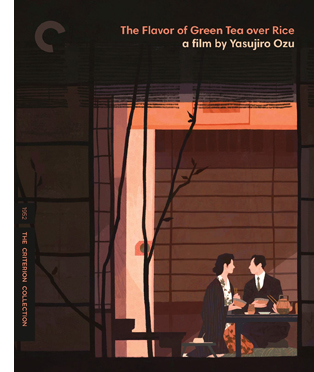
Ozu’s films from the 1950s on were typically planned in the winter, shot in spring and summer, and premiered in the fall, as if he were determined to document each year’s good weather. Ozu and Noda began writing Green Tea on 29 February and finished on 1 April, sometimes preparing three scenes a day. After consulting with Shiro Kido, the studio head, they revised the script. Ozu’s efficiency in planning every scene and sketching every shot allowed production to proceed fast. The crew began shooting on 7 June, in an office set. They finished on 13 July (“Finally, rest!”) and The Flavor of Green Tea Over Rice premiered on 1 October.
Pretty intensive work. But you wouldn’t know it from the companion notebooks. Among chronicles of naps, baths, social gatherings, changing weather, baseball games, and bar-hopping with friends, how did they get any work done? Above all there’s Ozu’s careful record of his alcohol intake (“drank until 2 AM”). A stomach ache makes him think he might have an ulcer. “I must resolve not to drink too much. And stick to it!” Today we would call him a high-functioning alcoholic. “With the whisky I drank this morning and the shumai I brought back from Tokoen, I wasn’t at all hungry tonight.”
As in his films, the everyday and the unusual get equal treatment. While staying at one inn, he calmly observes the arrival of a woman’s baseball team. And he remained a cinephile. He’s happy to interrupt an evening of dining and drinking to go see William Dieterle’s September Affair (1950).
The film that resulted, I suggest in the supplement, modulates between satire and a generous comedy that gives the main characters, no matter their failings, moments of warmth and dignity. With a light hand Ozu summons up narrative parallels, and he spotlights the split between men’s culture and women’s culture. A troubled marriage is given due weight, but it’s saved by graciousness, as when (above) Mokichi rescues Taeko’s sleeve from the water in the sink.
Ozu carries the humor down to the fine grain of technique, teaching us to play a private cinematic game in which the characters participate all unawares. The Criterion creative team has ingeniously used split screens to help me show the evolution of stylistic patterns across the film. Shedding my Mr. Rogers sweater for a sport coat, I try to crack the mystery of those eerie tracking shots. Like the situations and the dialogue, these barely moving images ought to make you smile.
Thanks to producer Elizabeth Pauker and her colleagues at Criterion, especially Peter Becker and Kim Hendrickson. Thanks as well to Erik Gunneson and James Runde here at UW–Madison.
Ozu’s diaries of shooting The Flavor of Green Tea over Rice are available, with helpful annotations, in Yasujiro Ozu: Carnets 1933-1963, trans. Josiane Pinon-Kawataké (Editions ALIVE, 1996), 267-318.
My book, Ozu and the Poetics of Cinema, is available for free here. Color pictures and everything! But be patient; it’s big and takes a while to download. There are many entries on Ozu and Donald Richie elsewhere on this site.
What Did the Lady Forget? (1937).












